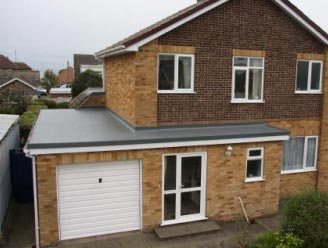Here at Amber Flat Roofing, we specialise in Fibreglass Roofing installations, so we know there are a number of benefits associated with it.
Fibreglass roofing is perfect for domestic customers, as it is lightweight yet still strong enough to withstand bad weather conditions. It’s also resistant to everyday wear and tear, so you won’t have to worry about replacing or repairing your roof for many years.
Common domestic applications for Fibreglass roofing are garages, extensions, balconies and verandas.
What is Fibreglass Roofing?
Fibreglass roofing is a type of roofing material that uses an ultra-strong, lightweight fibreglass composite material as its base. This material is typically reinforced with silicone and embedded in a protective coating to provide durability and flexibility.
Fibreglass roofing is an excellent option for both residential and commercial structures due to its various advantages. Firstly, fibreglass roofing is highly resistant to fire, meaning it can provide superior protection against the spread of flames in a structure. It is also very lightweight, making it easy to install onto existing structures without needing significant structural reworking. Furthermore, fibreglass roofing offers superior weather resistance and holds up better than traditional materials in extreme climates like hail, strong winds and heavy rain. Additionally, fibreglass roofing requires little maintenance over its long lifetime and is resistant to many chemical compounds such as oil and petrol.
How Is Fibreglass Roofing Installed?
Fibreglass roofing is typically installed onto existing structures by laying a mesh material on top of insulation panels. The mesh and insulation are then covered with a layer of resin that is strengthened with a series of layers of fibreglass matting. This layer acts as a waterproof barrier and also helps to reinforce the underlying structure. Finally, the completed roofing surface is coated with an appropriate sealant for added protection against the elements.
The resin and matting layers of fibreglass roofing serve two primary purposes. Firstly, the resin layer helps to create a waterproof barrier that keeps water away from the underlying insulation material. Secondly, the layers of fibreglass matting provide strength and rigidity to the roofing structure, helping it withstand long-term exposure to wind, rain, and other weather conditions. This combination of materials creates a durable and fire-resistant roofing solution that is sure to last for many years.
Fibreglass Roofing is Low Maintenance.
Fibreglass roofing is low maintenance because it doesn’t require sealants or paints to be periodically applied, and it does not rot or corrode like other roofing materials. It’s also resistant to UV radiation and temperature extremes, meaning that it won’t fade over time or become brittle due to extreme temperatures. The material is also highly durable and won’t need replacing for many years, as long as there are no significant physical damages.
Fibreglass roofing does not need to be maintained very often. Generally, it only needs to be inspected for any physical damage or areas that could need repair. If repairs are needed, they can typically be done quickly and easily. Ideally, the roof should be inspected at least once a year, but more often if it is exposed to extreme weather conditions or other elements that could potentially cause damage.


